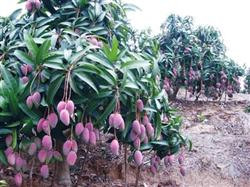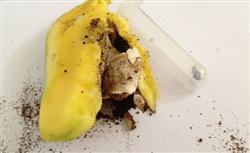Cultivation techniques of Mango in four Seasons

This variety was introduced from Thailand in 1990 and was selected from its excellent asexual breeding population for several years. After four consecutive years of multi-point planting experiments in Guangdong, Guangxi, Yunnan and other places from 1996 to 1999, the genetic characteristics of the excellent characters were stable. it has the following characteristics: first, it can blossom and bear fruit in all seasons of the year: first, it can blossom from late February to late March and fruit mature from late June to late July; the second plant blossoms in late April and ripens in late July. The third plant blossoms from late July to early August and the fruit matures in late November; the fourth plant blossoms in late September and ripens from March to April of the following year. Second, the flowering period can be adjusted artificially and the flowering of four seasons mango can be adjusted artificially without low temperature. under natural conditions, as long as cultivation techniques (such as pruning, shaping, spraying or dripping growth regulators), can be adjusted to blossom and bear fruit in any season at will. Third, it is easy to grow and bear fruit early. Mango, like other mango varieties, has fast growth rate and can obtain yield through extensive management. when grafted seedlings are planted in spring, they can blossom and bear fruit in autumn. Fourth, strong resistance, wide adaptability, four seasons mango resistance to stem rot, medium resistance to anthracnose, corner spot. As long as fruit bagging is implemented, more than 90% of the high-quality commercial fruits can be obtained. The drought tolerance is stronger, and the cold resistance is stronger than Zihuaomang. Flowering at 35 degrees Celsius, it can still blossom and set fruit, and it lasts about 80 days from Xiehua to fruit ripening. Where ordinary mango trees can live, they are suitable for planting mangoes in the four seasons. 5. After planting with high yield and high yield performance, the average annual plant yield is more than 3 kg in the second year, more than 15 kg in the third year, and more than 30 kg in the fourth year, which is one of the highest yield mango varieties in China. Sixth, the appearance of the fruit is beautiful, the quality is excellent, the appearance of the four seasons mango fruit is beautiful, and the single fruit weighs 200-300 grams. The flesh is thick, golden, less fiber, the edible rate is 76-83%, the soluble solid content is 20-24%, and the kernel is thin and slender. More than 60% of mature fruits after September show no nucleolus. The quality is better than the world famous brand mango-Lu Song Mang. Due to the strong off-season fruiting characteristics and easy artificial adjustment of the yield period, this variety can obtain better economic benefits, so it is worth popularizing the planted varieties. Key points of cultivation techniques: 1. Choose loose soil and fertile land for planting: due to the large amount of mango fruit in the four seasons, more times and faster growth rate, there are more fertilizer and water than other varieties. 2. As long as the tree is strong, high-yield and high-quality fruit can be obtained. 2. Prevent young and big trees from blooming sporadically and promote exuberant vegetative growth. Spray gibberellin + 0.3% 0.5% urea solution once a month in the season when flowers and fruits are not needed. (note: the dosage of gibberellin is 50-80ppm in summer and autumn and 100-150ppm in winter and spring). 3. Artificial florescence regulation method: from April to October every year, about 50 days before the selected flowering date, when the new shoots are ripe, spray 15% paclobutrazol (300g / 100jin water) + 300ppm ethephon (ethephon content is 40%) + 0.5% potassium dihydrogen phosphate (preferably potassium nitrate) about 30 days after application. 4. Apply the fertilizer of promoting flower and strengthening flower: (when the flower ear is 5 cm, spray 400 times cytokinin + Lvwang 2 (high nitrogen), at the same time, apply 1-2 rotten water fertilizer and add 0.5% multi-component compound fertilizer. 5. Bagging: after the fruit thinning, the fungicide pesticide is sprayed, and then the fruit is bagged. Use bluish blue plastic sand bags in summer, non-woven bags in winter or wax-treated paper bags all year round. 6. pest control: the pest of mango in the four seasons is relatively small, mainly to prevent diseases. (1) pay attention to the control of mango heart borer at the beginning of each heading, and it is found that the insect can spray 20% permethrin 2000-3000 times, 40% Lesbon 1000 times or 40% omethoate 800 times. (2) the main diseases of mango are anthracnose, bacterial angular spot and downy mildew. In the prevention and control of diseases in fruit protection work throughout the year, the key is before flowering and after fruit setting, the medication procedure is as follows: after spraying 1-2 times with Spock or methyl topiramate or methomyl, and then spraying Bordeaux solution or 77% cupric oxychloride.
- Prev

Comprehensive management adopts new technology to protect flowers and fruits of mango.
Mango winter jujube fruit is easy to protect the fruit is difficult, from the young fruit stage to the white ripening period has been falling fruit, and what is puzzling is always falling big leftover small, so that jujube farmers are very distressed. In recent years, mango has been tested by taking various measures to protect flowers and fruits, and the following new technologies of comprehensive management have been obtained to solve this problem: 1.
- Next

How to prevent early flowering of mango
1. Mango leaf-cut weevil is widely distributed, adults feed on mango tender leaves, causing the leaves to dry up, or females lay eggs on the tender leaves and bite off the tender leaves from the base, affecting plant growth. Control methods: during the growth of tender shoots, ① picked up the fallen leaves of the injured plants every 3 days, dried them in the sun and burned them, killing larvae.
Related
- Moge, come on! The staff of the peasant association in the producing area of cantaloupe were frightened when the crowd gathered.
- Causes and Solutions of low Fruit setting rate of Apple
- Symptoms and control measures of passion fruit virus disease
- Fruit growing lesson: how do apple orchards keep high yields?
- Can you build orchards in the mountains? What are the pros and cons?
- How to manage the coloring period of Crisson grape?
- This paper introduces the processing technology of two kinds of fig products.
- How much is a month for retired teachers in rural areas by 2020?
- How can strawberry planting increase sugar content? We should pay attention to management in many aspects.
- What are the cultivation techniques on how to improve the yield of golden fruit?

